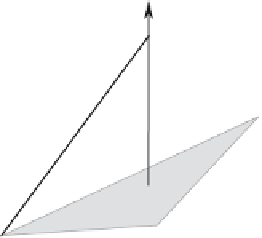Graphics Reference
In-Depth Information
x
a
y
a
z
a
x
b
y
b
z
b
x
c
y
c
z
c
=
·
×
=
·
×
=
·
×
=−
·
×
=−
·
×
=−
·
×
a
b
c
b
c
a
c
a
b
a
c
b
b
a
c
c
b
a
Applying these relationships to Eq. (6.29), we obtain
kp
21
p
31
−
k
×
p
21
·
p
31
vp
21
p
31
=
=
v
×
p
31
·
p
21
−
vkp
31
v
×
p
31
·
k
−
vp
21
p
31
=
r
=
(6.31)
v
×
p
31
·
p
21
−
vp
21
k
k
×
p
21
·
v
−
vp
21
p
31
=
s
=
v
×
p
31
·
p
21
Note that the above equations for , r, and s contain two common terms:
k
×
p
21
and
v
×
p
31
.
If these are computed separately, we can write
m
·
p
31
n
·
k
m
·
v
=
r
=
s
=
p
21
n
·
p
21
n
·
p
21
n
·
where
m
=
k
×
p
21
n
=
v
×
p
31
Let's put the above theory into practice using a triangle formed from the points P
1
020,
P
2
004, and P
3
312 with a ray
=
+
p
t
v
where
t
=
4
j
v
=−
j
+
k
which will intersect the triangle at P
2
, as shown in Fig. 6.18.
Y
T
P
1
t
λ
v
P
3
X
P
2
Z
Figure 6.18.












